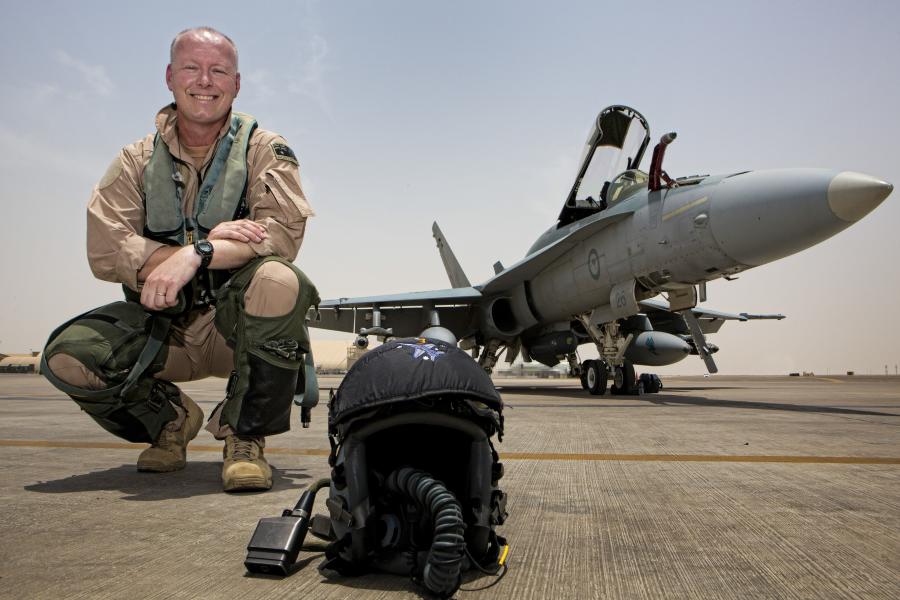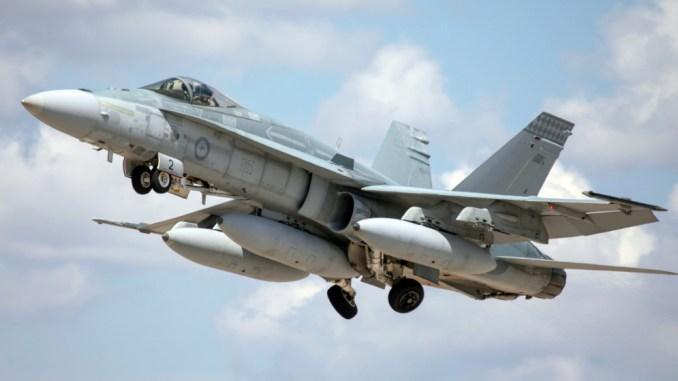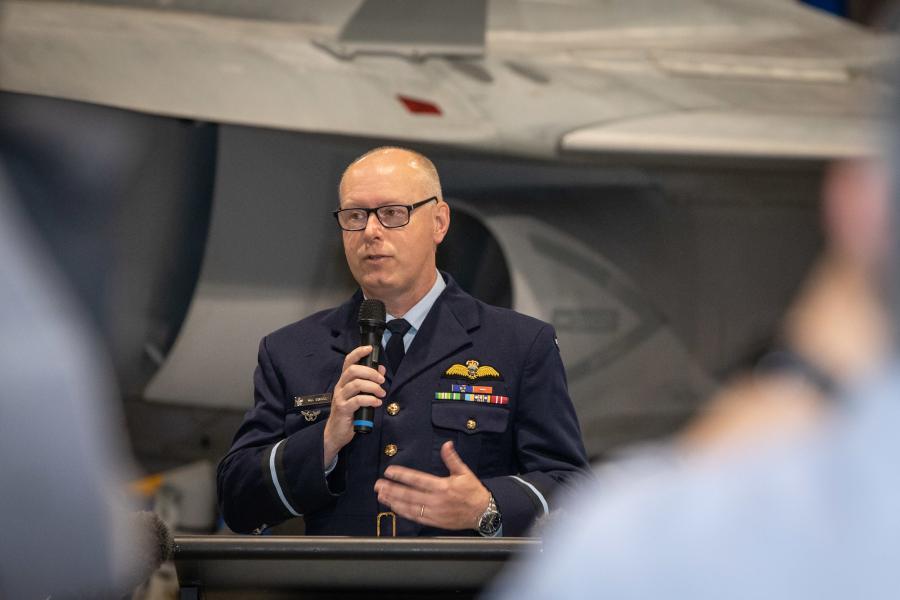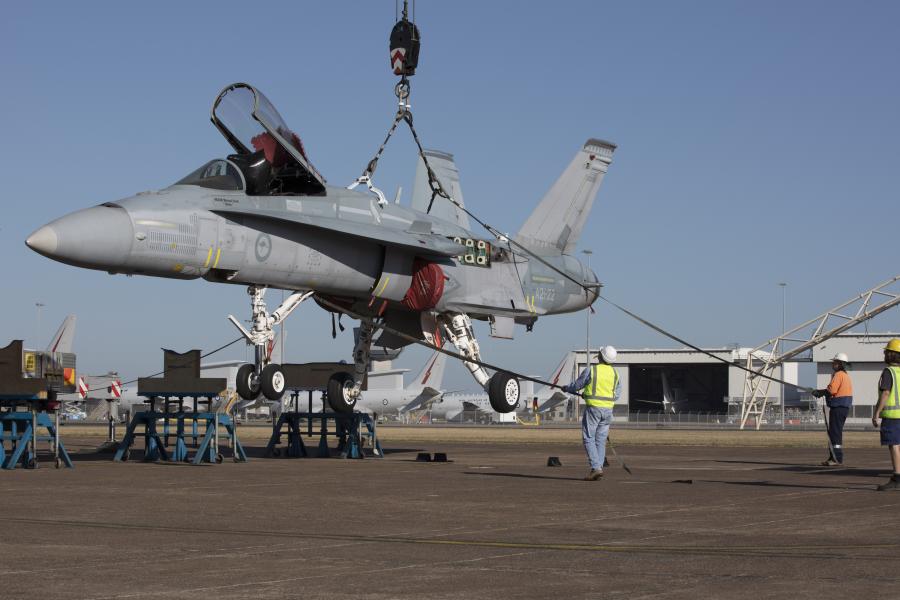'I felt lucky every single day to be paid to turn up to work and fly it'

Air Commodore Philip Gordon during Operation Okra. Photo: Courtesy Defence
Air Commodore Philip Gordon has fond memories of flying the F/A-18 Classic Hornet.
“When I first flew the Hornet in 1993, it still had that new car smell, and I felt lucky every single day to be paid to turn up to work and fly it,” he said.
“It introduced advanced systems that changed the way that we fly and … proved itself time and again in operations at home and abroad.”
Today, one of the Hornets he flew is part of the National Collection at the Australian War Memorial in Canberra.
A multi-role fighter aircraft, capable of air-to-air and air-to-ground missions, the F/A‐18A/B Classic Hornet was acquired by the Royal Australian Air Force in the mid-1980s to replace the Dassault Mirage IIIO fighter fleet, which had been in service since 1963.
Between 1985 and 1990, the air force introduced 75 Hornets to operate across No. 2 Operational Conversion Unit and Nos 3, 75, and 77 Squadrons, located at RAAF Base Williamtown and RAAF Base Tindal.
Its introduction marked one of the biggest leaps in technology the air force had seen.

The first two Hornets (A21-101 and A21-102) were flown from California to Williamtown in May 1985 in a record-breaking 15-hour, non-stop flight covering more than 12,000 kilometres; each Hornet was refuelled 13 times by accompanying US Air Force tankers.
The next two Hornets (A21-103 and A21-104) had already arrived in Australia, partially disassembled in the back of a C-5 Galaxy US military transport aircraft. Having arrived at Avalon in June 1984, they were to be reassembled by the Government Aircraft Factories, as were the 71 other Hornets that followed.
Since then, the Hornet has been deployed on a number of military operations, most notably the NATO-led mission following the 9/11 terrorist attack in the US.
Missions included safeguarding the US air base in Diego Garcia, from where operations in Afghanistan were launched, and deployments to Iraq, where it attacked enemy targets and provided air cover for the SAS.
After three decades of service, and more than 400,000 flight hours across thousands of missions, the air force’s fleet of single-seat F/A-18A and two-seat F/A-18B Classic Hornets was retired from service in 2021.

The Memorial’s F/A-18A Hornet, A21-022, was deployed to the Middle East in 2003, as part of Operation Bastille, and Operation Falconer. It took part in 20 combat missions, becoming the first RAAF aircraft to drop a bomb in combat since the Vietnam War, and the first fighter to do so since Korea.
It returned to the Middle East as part of Operation Okra in 2016–17, flying more than 50 combat missions against Islamic State targets in Iraq and Syria. It was retired from the air force on 9 June 2020 after more than 30 years of service, and 6,131.5 flying hours.
For Air Commodore Philip Gordon, the aircraft is particularly special.
“Many of us have personal stories about our involvement with this aircraft, and aircraft 22 in particular,” he said.
“When I joined the air force in 1987, we were transitioning from the venerable Dassault Mirage III.
“As a boy, I looked back at the Mirage and wondered at this massive engine, its delta wings, and its tiny cockpit. They could fly very fast for a very short period of time – mostly in a straight line – and then we had a real generational change from the third generation aircraft to the fourth generation ...

F/A-18A Hornet A21-022 is lifted by a crane onto stands at RAAF Base Williamtown prior to its move to the Australian War Memorial's Treloar Technology Centre. Photo: Courtesy Defence
“The Hornet has been a remarkable aircraft for Australia that I’ve had the pleasure of flying throughout my career.
“In my last flight in a Hornet in 2016, in the skies over Iraq … in the campaign against ISIS, I paused to reflect on how it was that a 30-year-old aircraft, was so effectively contributing to the coalition effort.
“It really is testament to the thousands of defence and industry personnel who work tirelessly … to deliver that capability.
“You think about maintaining a 30-year-old car and keeping it relevant on the racetrack around Bathurst. That’s no mean feat.
“But the Hornet’s time has come. It’s gone as far as it can. It’s time for that next generational change as we make our way to a fifth generation – F35A Lightning 2 Joint Strike Fighters.
“Young pilots who are joining the air force now will no doubt look upon the Hornet as I did upon the Mirage, and wonder how we ever got the job done.
“I’d really like to thank the Australian War Memorial for preserving this piece of really important Australian history … not just for the many thousands of Defence people who have got a direct connection with the Hornet … but for the Australian public who can reflect on the story of the Hornet ... and its wonderful place in our aviation history.”
The F/A-18A Hornet (A21-022) aircraft is currently stored at the Memorial’s Treloar Technology Centre in Mitchell.